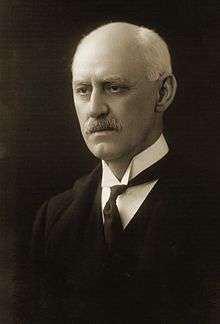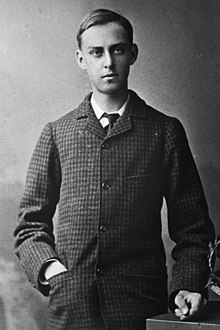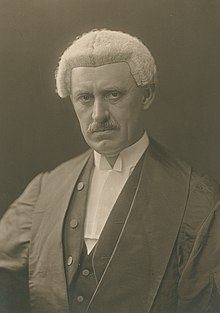George John Robert Murray
Sir George John Robert Murray KCMG KC (27 September 1863 – 18 February 1942) was a judge from 2 April 1913 until 18 February 1942 on the Supreme Court of South Australia, which is the highest ranking court in the Australian State of South Australia. He was Chief Judge from 20 January 1916 until 18 February 1942.[1]
Sir George Murray KCMG KC | |
|---|---|
 | |
| 4th Chief Justice of South Australia | |
| In office 20 January 1916 – 18 February 1942 | |
| Preceded by | Sir Samuel Way |
| Succeeded by | Sir Mellis Napier |
| Personal details | |
| Born | 27 September 1863 Magill, Colony of South Australia |
| Died | 18 March 1942 (aged 78) Magill, South Australia |
| Relations | Alexander Borthwick Murray (Father) |
| Alma mater | University of Adelaide Trinity College, Cambridge |
Early life

George John Robert Murray was born at Murray Park, Magill, near Adelaide, the second surviving son of Alexander Borthwick Murray, a pioneer sheep-breeder and South Australia politician, and his second wife Margaret, née Tinline.[2] George Murray and was first educated at John L. Young's Adelaide Educational Institution, then two years at the Royal High School, Edinburgh[3] and St Peter's College, Adelaide, where he won the Prankerd, Wyatt, Christchurch and Farrell scholarships. At the University of Adelaide Murray won the John Howard Clark scholarship for English literature in 1882, qualified for the BA degree in 1883, and won the South Australian Scholarship. This allowed him to study at the University of Cambridge where he took his B.A. and LL.B. degrees, being bracketed senior in the law tripos in 1887.[4] Murray also represented Cambridge in cricket and rowing.[2]
Legal career

Murray was called to the bar at the Inner Temple in 1888, returned to South Australia and was associate to Sir Samuel Way until 1891, when he began practising as a barrister, initially in partnership with William Ashley Magarey as Murray & Magarey. He was soon successful, and in 1906 became a KC, the first Adelaide graduate to obtain this distinction. In 1909 he paid a visit to England and took his LL.M. degree, and in 1912 he was appointed a judge of the Supreme Court of South Australia. He had been on the council of the university since 1891, and in 1915 was appointed vice-chancellor. In 1916 he succeeded Sir Samuel Way as chief justice of South Australia and later the same year became chancellor of the university. His interest in educational problems and the university was shown in many ways, and his benefactions included £1000 for the building fund of the university in 1920, £2000 for general purposes in 1931, and £10,000 for a men's union building in 1936. He also renounced his life interest in the estate of his sister the value of which was estimated at £45,000. This was left to the university in 1936. Murray administered the government of South Australia on numerous occasions in the absence of the Governor.[5] Murray visited Europe again in 1935, and died at Adelaide following an operation for appendicitis on 18 February 1942; he was buried privately beside his sister in St George's Church of England cemetery, Magill.[2] He was created K.C.M.G. in 1917. He was unmarried.
Summary and legacy
Murray had a reserved manner, at times giving the impression that he was cold in his outlook. However, this was not the case as Murray was in reality warm-hearted, broad-minded, and generous, always anxious to assist deserving causes so long as it could be done without ostentation. As chancellor of the university for 25 years, he was held in honour and affection by teaching staff and students alike. As a counsel Murray was not a dramatic pleader, but was clear and systematic in his presentation of technical cases, and masterly in the marshalling of his arguments, excelling in equity cases. As a judge he showed himself to be an able lawyer with a wide knowledge of human nature, encouraging timid witnesses, and dealing firmly with those of a prevaricating or shifty character. His outlook at times may have seemed severe, but this came from his determination to carry out the law, and he was always diligent and painstaking. He was much esteemed by the legal profession. He was lieutenant-governor of South Australia for practically the whole period of his chief justiceship, on many occasions administered the government, and his experience was always available to incoming governors. He sought neither praise nor public approval, but at the time of his death he was the most distinguished South Australian of his period.
In 1908 he endowed the University of Adelaide with £1,000 to establish the Tinline Scholarship in History in recognition of the family of his mother, born Margaret Tinline (c. 1823 – 17 August 1907).[6]
Every year at St. Peter's College the house with the highest performance and effort in house events is awarded the George Murray shield.
References
- "Leaders in their fields". About the University. University of Adelaide. Archived from the original on 1 February 2009. Retrieved 17 January 2007.
- Alex C. Castles, 'Murray, Sir George John Robert (1863–1942)', Australian Dictionary of Biography, Vol. 10, Melbourne University Press, 1986, pp 640–641. Retrieved 27 December 2013
- "Death of Sir George Murray". The Advertiser. Adelaide. 19 February 1942. p. 4. Retrieved 1 September 2012 – via National Library of Australia.
- "Murray, George John Robert (MRY884GJ)". A Cambridge Alumni Database. University of Cambridge.
- "Table A: Governors and Administrators" (PDF). Parliament of South Australia. 2010. Archived from the original (PDF) on 12 March 2011. Retrieved 27 December 2013.
- "The Tinline Scholarship". The Register. LXXIII (19, 147). Adelaide. 26 March 1908. p. 4. Retrieved 6 August 2016 – via National Library of Australia.
- Serle, Percival (1949). "Murray, George John Robert". Dictionary of Australian Biography. Sydney: Angus and Robertson.
- Emerson, Dr. John, First Among Equals – Chief Justices of South Australia Since Federation, University of Adelaide Barr Smith Press, Adelaide, 2004, pp 57–108.
External links
- Supreme Court History courts.sa.gov.au
| Legal offices | ||
|---|---|---|
| Preceded by Sir Samuel Way |
Chief Justice of South Australia 1916–1942 |
Succeeded by Sir Mellis Napier |
| Government offices | ||
| Preceded by Sir Samuel Way |
Lieutenant-Governor of South Australia 1916–1942 |
Succeeded by Sir Mellis Napier |
| Academic offices | ||
| Preceded by Sir Samuel Way |
Chancellor of the University of Adelaide 1916–1942 |
Succeeded by Sir William Mitchell |